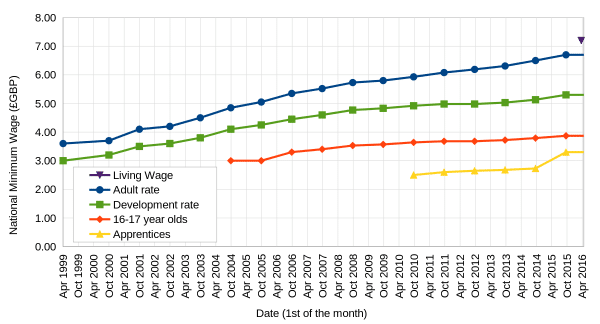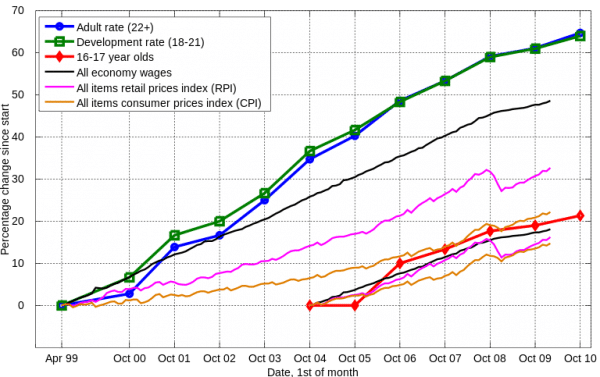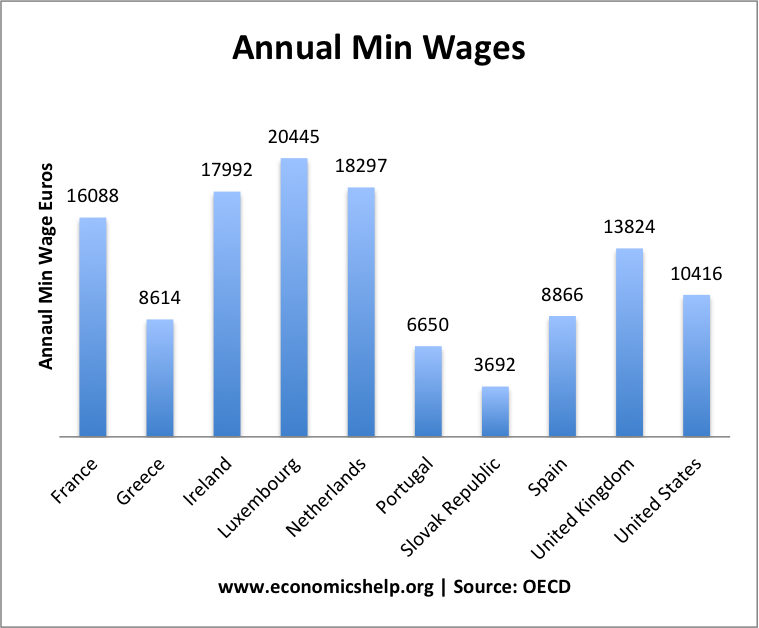UK Minimum Wage
- The National minimum wage rate is currently £8.72 for workers over 25 (from April 2020). The minimum wage was introduced in April 1999 (at £3.60) and is the legal minimum that employers can pay.
- The aim of the National Minimum Wage is to help increase incomes of the low paid. It has become more important in a labour market characterised by a decline in trade unions and the growth of low-paid service sector jobs.
- Free market economists, such as Milton Friedman argued a National Minimum Wage would lead to unemployment because firms cannot afford to pay the workers.

- However, since it was introduced in 1999, the effect on unemployment has been negligible. In the UK, there are record levels of employment, lower natural rates of unemployment and unemployment only increasing temporarily because of the recession in 2008.
- However, although the impact has been less than some economists anticipated, future increases could place a strain on some employers.
- However others argue that Minimum Wage rates are still too low and do not provide a ‘living wage‘ in certain areas of high housing costs, such as London.
National Minimum Wage Rates from April 2020
- £8.72 – 25 and over
- £8.20 – Age 21-24
- £6.45 – Age 18-20
- £4.55 – Under 18
- £4.15 – Apprentice rate.
Source: Direct Gov (1)
It is estimated 1 million workers (5% of the workforce) receive the national minimum wage.
Forecast for National Minimum Wage
By 2020, the National Minimum Wage could reach £9.00 or more. The Resolution Foundation have suggested by 2020 the minimum wage could affect one in nine workers.
History of National Minimum Wage
| Year | 21 and over | 18 to 20 | Under 18 | Apprentice |
|---|---|---|---|---|
| 2015 | £6.70 | £5.30 | £3.87 | £3.30 |
| 2014 | £6.50 | £5.13 | £3.79 | £2.73 |
| 2013 | £6.31 | £5.03 | £3.72 | £2.68 |
| 2012 | £6.19 | £4.98 | £3.68 | £2.65 |
| 2011 | £6.08 | £4.98 | £3.68 | £2.60 |
| 2010 | £5.93 | £4.92 | £3.64 | £2.50 |
| 1999 | £3.60 | £3.00 |

Increased importance of minimum wage

Note: Since October 2010, the National Minimum Wage has increased from £5.93 to £8.72 (2020), while average wages have stagnated.
The National minimum wage has risen faster than average wages, especially since 2007
Is the minimum wage a good idea?
Benefits of a Minimum Wage
- Reduces poverty. The minimum wage increases the wages of the lowest paid. These workers will have increased income and will reduce relative poverty.
- Increase productivity. The efficiency wage theory states that higher wages can increase the incentive for people to work harder and thus higher wages may increase labour productivity. If firms have to pay higher wages, they may put more focus on increasing labour productivity, which increases efficiency of the economy
- Increases the incentives to accept a job. With a minimum wage, there is a bigger difference between the level of benefits and the income from employment. A minimum wage could also increase the participation rate as the benefits of work become greater and more worthwhile.
- Increased investment. Firms will have an increased incentive to invest and increase labour productivity because labour is more costly. In the long-term, this can encourage greater investment and labour productivity – an economy based on high value added, rather than competing on low wages.
- Knock on effect of minimum wage. Although only 5-7% of workers are on the minimum wage, the minimum wage has an indirect effect on the wages of those just above the minimum wage. If the minimum wage floor rises, firms may need to increase wages for those just above the minimum wage floor – to maintain pay premium for experienced workers.
- Counterbalance the effect of monopsony employers. If firms have Monopsony power they can drive wages down by employing fewer workers. However, minimum wages will make this more difficult. Therefore a minimum wage could have a positive effect on employment.
Diagram of Minimum Wage on Monopsony

A monopsony pays a wage of W2 and employs Q2. If a minimum wage was placed equal to W1, it would increase employment to Q1. Therefore, in some circumstances, it is feasible that a minimum wage could actually increase employment – or at least not cause any employment.
Arguably many firms can afford to pay higher wages, a minimum wage helps redistribute income in society.
Problems of Minimum Wage
1. Scope for unemployment If labour markets are competitive, a minimum wage above the equilibrium could cause a fall in demand for workers, and excess supply

Above the equilibrium, the national minimum wage can cause unemployment of Q3-Q2
2. Certain industries vulnerable to a ‘living wage’ It is argued labour-intensive industries, where labour costs are a high percentage of overall costs could be hit by a high National Minimum Wage. In particular care workers for old people are often paid the Minimum Wage. With a rise in number of old people needing care, this could significantly increase costs for old-age care.
3. Regional variations in wages. A big problem with a national minimum wage is that wages vary enormously within the UK. In London, with higher costs of living, not many people get the minimum wage because wages are relatively higher. However, in some areas, a minimum wage of £9 could cause significant unemployment, especially in labour-intensive industries. It is estimated that in 10 hot spot low pay areas 30% of workers are on the Minimum Wage. (1)
4. Higher wages passed onto consumers. An increase in the minimum wage could cause firms to increase prices and pass the costs onto consumers
5. More and more workers are getting stuck on the minimum wage More than 1 million workers receive the minimum wage. The highest proportion are amongst women, ethnic minorities and young people. The fear is that a minimum wage encourages firms to keep more workers on the lowest band of wages.
6. Incentive to work in black market. A high minimum wage may create an incentive for firms to find ways to avoid declaring wages to the government but offer cash-in-hand work in the unofficial/underground economy. This can lead to the exploitation of labour and is a concern in some industries – especially with higher rates of migrant labour.
What is the best rate to set?
The desirability of a minimum wage depends on various factors:
- State of the economy. During strong growth and falling unemployment, it is easier for firms to pay higher wages.
- The elasticity of demand. Is demand for labour wage inelastic? or will some firms be very sensitive to higher wages? Some service sector jobs like hairdressers/cleaners may argue a small increase in their wage bill could lead to unemployment.
- Regional wage rates. Could you allow for regional differences in wages? (e.g. a London specific minimum wage)
- Type of labour market. Are labour markets competitive or monopsonistic?
- Is there scope for firms to increase labour productivity? and therefore be able to afford the wage increases.
- Percent of Median wages. One study found that the rate of the minimum wage compared to median wages is important. For example, Effect of minimum wages on low wage jobs, Jan 2019 found that a min wage set ” between 37% and 59% of the median wage—have yet to reach a point where the job losses become sizable.” (NBER Working Paper No. 25434, Effect of minimum wages on low wage jobs, Jan 2019)
International minimum wages
Most western economies adopt a legal minimum wage.
 Data from OECD from 2011
Data from OECD from 2011
Related
- Disadvantages of Minimum Wage
- Does A Minimum Wage – Does it reduce poverty?
- Living wage – arguments for a higher national minimum wage
References


